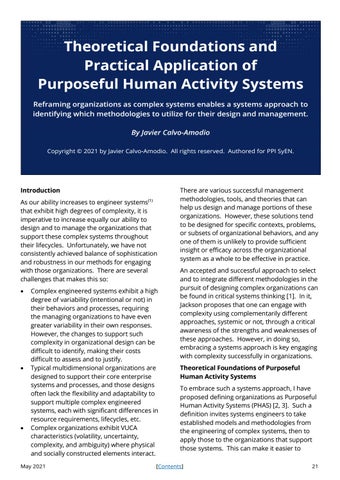Theoretical Foundations and Practical Application of Purposeful Human Activity Systems Reframing organizations as complex systems enables a systems approach to identifying which methodologies to utilize for their design and management. By Javier Calvo-Amodio Copyright © 2021 by Javier Calvo-Amodio. All rights reserved. Authored for PPI SyEN.
Introduction As our ability increases to engineer systems(1) that exhibit high degrees of complexity, it is imperative to increase equally our ability to design and to manage the organizations that support these complex systems throughout their lifecycles. Unfortunately, we have not consistently achieved balance of sophistication and robustness in our methods for engaging with those organizations. There are several challenges that makes this so: •
•
•
Complex engineered systems exhibit a high degree of variability (intentional or not) in their behaviors and processes, requiring the managing organizations to have even greater variability in their own responses. However, the changes to support such complexity in organizational design can be difficult to identify, making their costs difficult to assess and to justify. Typical multidimensional organizations are designed to support their core enterprise systems and processes, and those designs often lack the flexibility and adaptability to support multiple complex engineered systems, each with significant differences in resource requirements, lifecycles, etc. Complex organizations exhibit VUCA characteristics (volatility, uncertainty, complexity, and ambiguity) where physical and socially constructed elements interact.
May 2021
There are various successful management methodologies, tools, and theories that can help us design and manage portions of these organizations. However, these solutions tend to be designed for specific contexts, problems, or subsets of organizational behaviors, and any one of them is unlikely to provide sufficient insight or efficacy across the organizational system as a whole to be effective in practice. An accepted and successful approach to select and to integrate different methodologies in the pursuit of designing complex organizations can be found in critical systems thinking [1]. In it, Jackson proposes that one can engage with complexity using complementarily different approaches, systemic or not, through a critical awareness of the strengths and weaknesses of these approaches. However, in doing so, embracing a systems approach is key engaging with complexity successfully in organizations. Theoretical Foundations of Purposeful Human Activity Systems To embrace such a systems approach, I have proposed defining organizations as Purposeful Human Activity Systems (PHAS) [2, 3]. Such a definition invites systems engineers to take established models and methodologies from the engineering of complex systems, then to apply those to the organizations that support those systems. This can make it easier to
[Contents]
21
